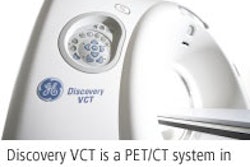Caution: Medication errors in radiology may be harmful to your health. A five-year report by the United States Pharmacopeia (USP) concluded that radiology errors were seven times more harmful than errors in other areas of medical practice. Critics called the report misleading in light of the low number of actual errors reported.
Results from the study, "MEDMARX Data Report: A Chartbook of 2000-2004 Findings from Intensive Care Units and Radiological Services," were presented in a USP-sponsored press conference on Wednesday.
According to the MEDMARX data, in 2004 approximately 249,000 actual and potential medication errors were received from the more than 850 hospitals and health systems that participate in the program, said Diane Cousins, vice president of USP's Center for the Advancement of Patient Safety.
"This report ('Medication Errors in Radiological Services') is a descriptive analysis of the actual records of errors submitted by facilities that subscribe to MEDMARX," she said. "It is not a scientific study."
For the five-year period covered in the publication, the group collected 2,032 actual and potential medication error reports it deemed to have occurred in radiological services from 315 hospitals and health systems. The majority of reporting institutions were general community hospitals (85%) with 100- to 300-bed capacities.
Broken out against the USP dataset, this represents 406 actual and potential errors per year, or about 1.3 actual and potential errors per facility per year for all procedures performed in the radiology department, nuclear medicine, and the cardiac cath lab combined.
"While we know some things about these hospitals, we don't know the number of procedures performed in each hospital in order to calculate risk," Cousins said.
USP defined radiological services as comprising cardiac catheterization laboratories, nuclear medicine, and the radiology department. The report states that cardiac cath labs were responsible for 40.6% (825) of the overall errors, while the radiology department was assessed 56.8% (1,155) of the errors. Nuclear medicine accrued 2.6% (52) of the total errors in the report. However, the nuclear medicine component represented only nine months of data collection (April-December 2004), according to USP.
The report authors wrote that "compared to the general MEDMARX dataset, the number of reported errors in radiological services was relatively small." In addition, the report states that fewer than 1% of the cited errors may have been connected to any sentinel event. However, according to USP, these medication errors were deemed more harmful than those in other healthcare areas.
"For the five-year study period of 2000-2004, medication errors involving radiological procedures and exams had the highest percentage of patient harm," said John Santell, director of educational program initiatives for the Center for the Advancement of Patient Safety. "Our study found that of the 2,032 reported medication errors, 12% were categorized as harmful. This percentage is seven times higher than the percentage of harm seen in the overall general MEDMARX data for the same five-year period."
For the three areas named as radiological service in the report, 28% of the errors were attributed to the wrong dose or quantity, 17% were due to the wrong drug, 17% to an omission area, and 12% to a prescribing error. Overall, 50.3% of the errors were credited to a performance deficit, 19.5% to procedures and protocols not being followed, 16.2% to a communication breakdown, 11.9% to inadequate monitoring, and 9.7% to medication contraindications.
Registered nurses in the cardiac cath lab were identified in the report as the staff making the initial error in 66.7% of their cases, with physicians responsible for 18.7%. Radiologic technologists were specified as the initial error creators in 49.7% of the cases in the radiology department, with registered nurses tallying 28.7% and physicians 11.7%. The nuclear medicine department showed similar results with nuclear medicine technologists assessed 46.5% of the initial errors, registered nurses 30.2%, and physicians 11.6%.
Radiology and nuclear medicine professional organizations have been quick to respond to the allegations in the USP report.
Dr. James Borgstede, chair of the American College of Radiology (ACR) Board of Chancellors, expressed his concern with the data in a telephone conversation with AuntMinnie.com.
"When you look at these errors with radiology, they're incredibly low," he said. "The ACR works for the day when all medical errors are eliminated. However, this report is deeply flawed and fails to relate the extremely low frequency of such errors in relation to the more than 570 million medical imaging procedures performed in the U.S. each year. This incredibly vague report does not provide evidence that imaging facilities operated by trained, certified physicians and certified nonphysician personnel present a significantly increased risk over other medical facilities in regard to medication usage."
Perhaps more important, patients who read the study author's conclusions in the popular media may be scared away from contrast-enhanced radiological studies.
"We're concerned that what may happen is that some patients who really need contrast may want to avoid it because they read about this report," Borgstede said. "The massive flaws in the report's methodology and its failure to provide context as to the scope of any errors reported seriously undermine the study's conclusions. To take this report as evidence of systemic failures in radiology facilities which represent an increased risk to patients is not only inaccurate, but irresponsible and potentially dangerous."
"What patients should be doing is looking for an ACR-accredited site to have their examination and a board-certified radiologist to interpret their exam," he said.
Cathy Parsons, president of the American Society of Radiologic Technologists (ASRT), issued a statement in response to the USP report calling for additional education for radiologic technologists in the following topics:
- The proper use, indications, and routes of administration for contrast media and other medications used in radiology
- Pharmacology, including drug interactions and contraindications
- Charting and documentation techniques
- Use of electronic medical records and information access and retrieval systems
- Communication skills as members of an interdisciplinary healthcare team
"The USP report indicates that medication errors often result from breakdowns in communication as a patient is transported from his or her care unit to the radiology department and back, or from the radiologic technologist's lack of access to patient information that other care providers have. The ASRT urges hospitals to address and correct these communication breakdowns. Effective interdisciplinary communication is necessary to ensure continuity of care," Parsons wrote.
Dr. Robert Henkin of the Society of Nuclear Medicine, a professor emeritus and former director of nuclear medicine at the Loyola University Medical Center in Maywood, IL, spoke with AuntMinnie.com about his thoughts on the USP report.
"I think USP raises some interesting issues," he said. "The most interesting issue they raise is that the difficulty in communication between nursing units and other places in the hospital."
"Most of the errors that they show as significant in their report are the result of the poor transmission of information from one place to another about a patient. Things like IV fluids, nonradiologic drugs, and such. Those are the things that really stand out in the USP report," Henkin said.
"We don't know how many procedures their data covers, and they don't know how many procedures their data covers. They didn't collect that information. We know from other data that the nuclear medicine error rate is about 0.01%, and that's about as low as you can get in error rate," he said.
By Jonathan S. Batchelor
AuntMinnie.com staff writer
January 19, 2006
Related Reading
Downstream systems integration key to CPOE effectiveness, December 29, 2005
Progress slow in improving patient safety in U.S. hospitals, December 16, 2005
Computerized physician order entry system linked with increased patient mortality, December 7, 2005
Mistakes tied to 2,000+ U.K. deaths last year - report, November 3, 2005
Diagnostic imaging and clinical information systems: An integration primer, March 14, 2005
Copyright © 2006 AuntMinnie.com



















